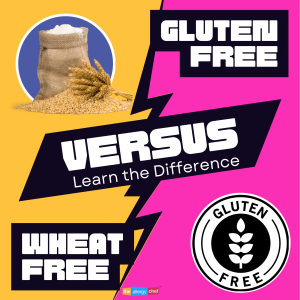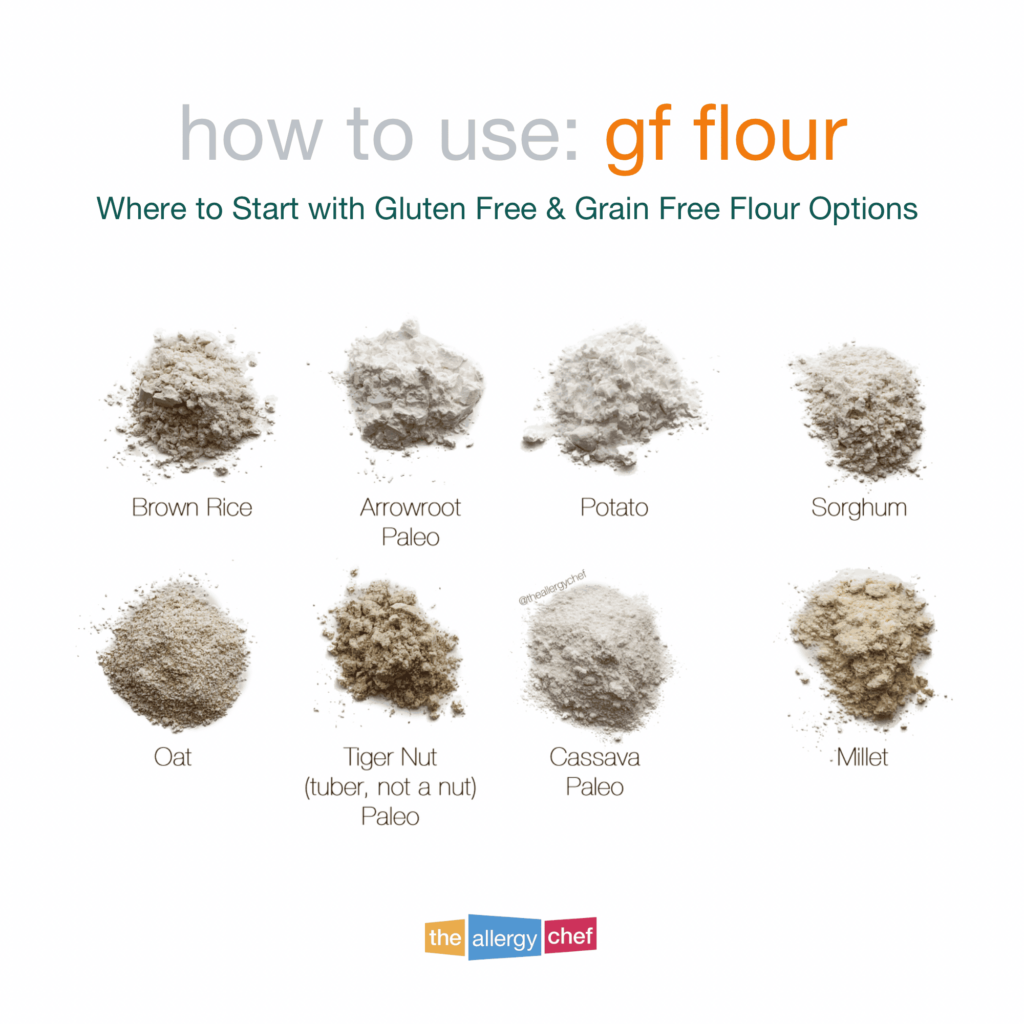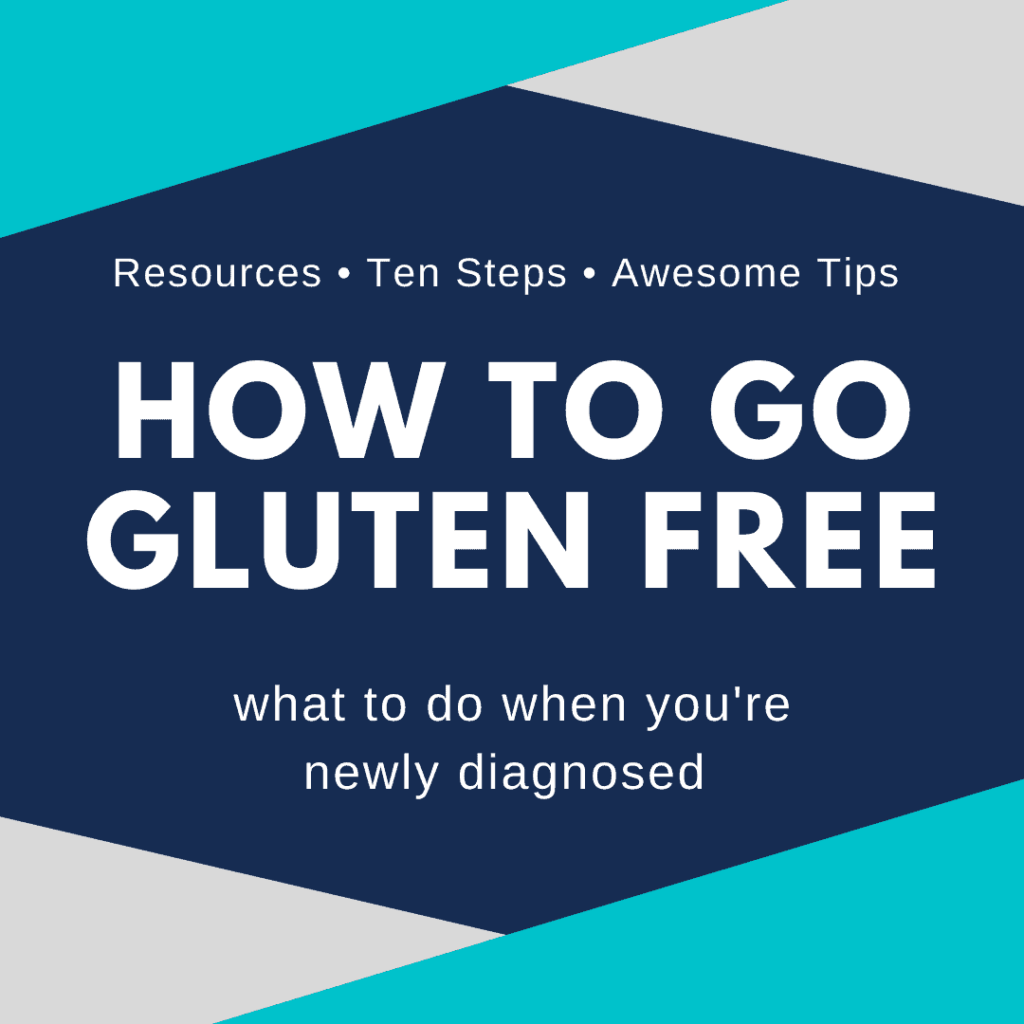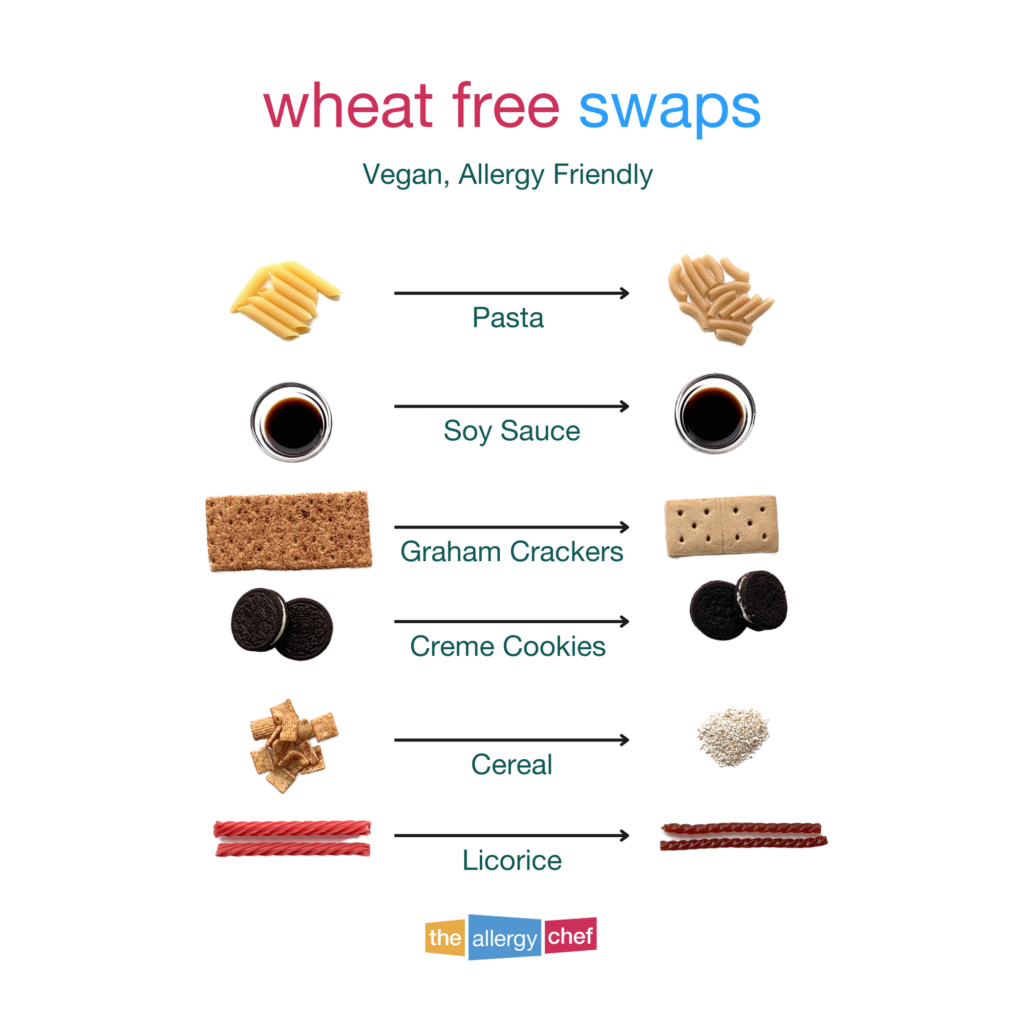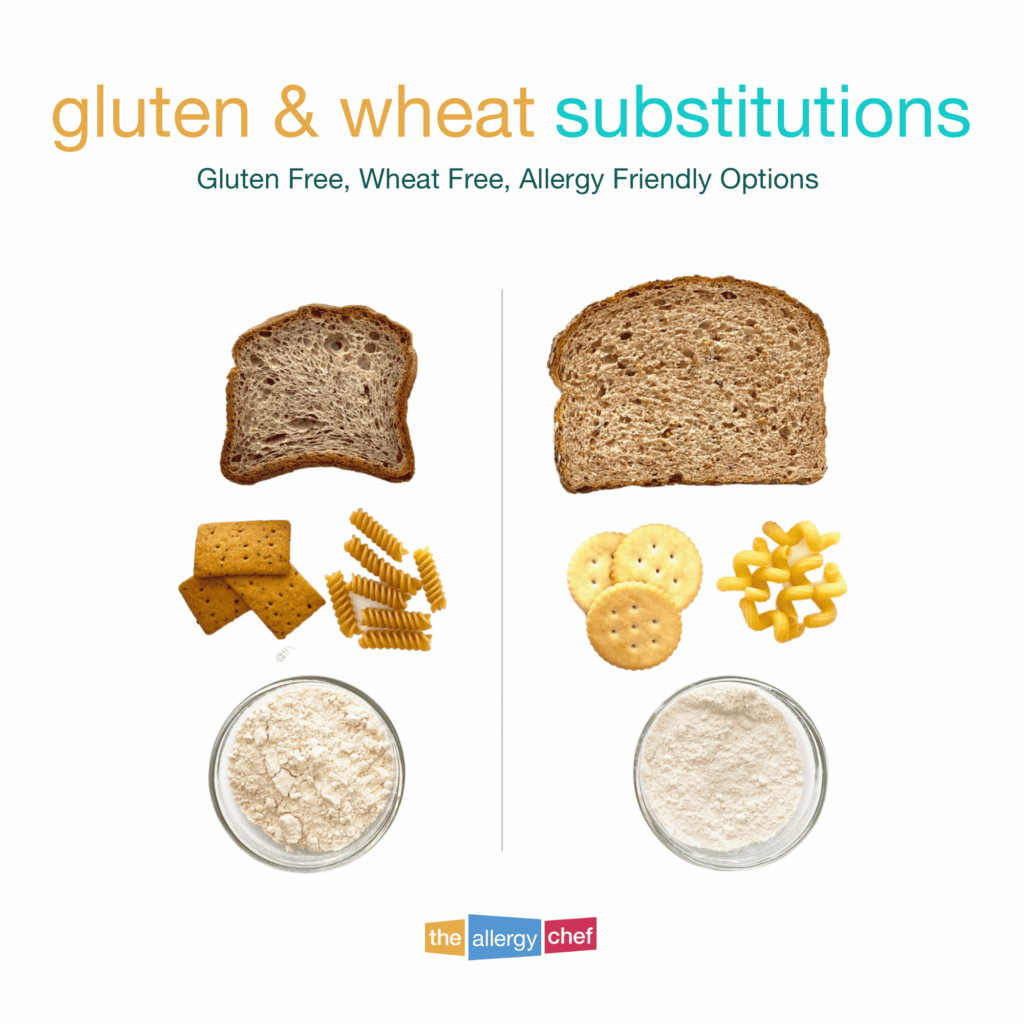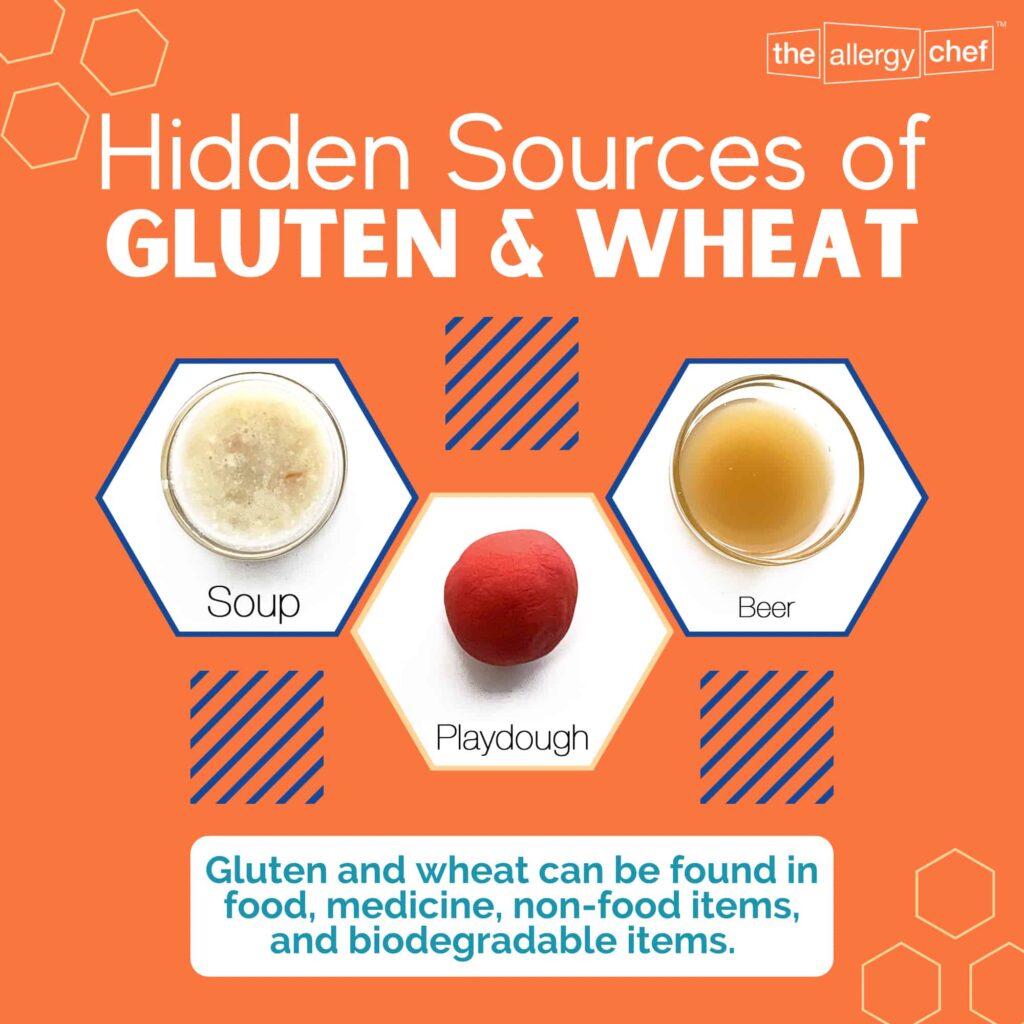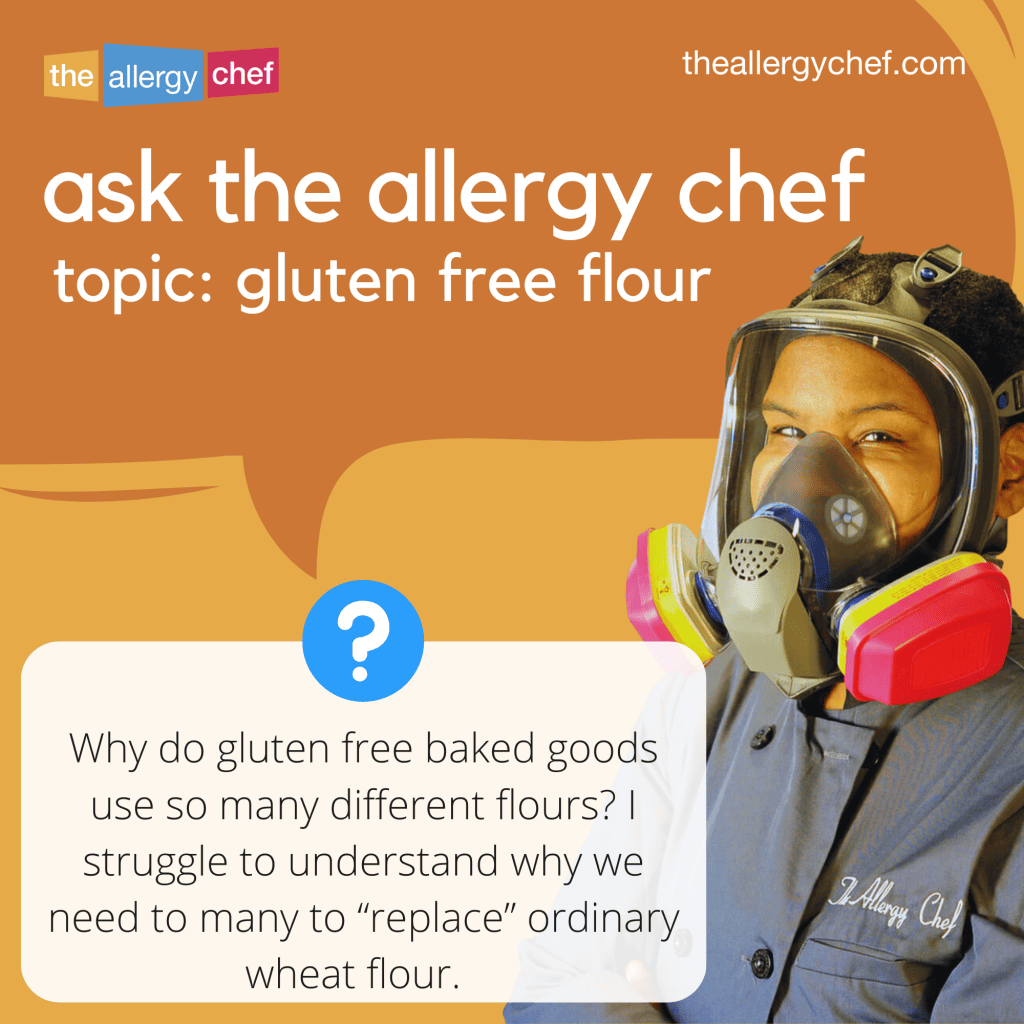Today we’re going to look at the difference between a wheat allergy and Celiac Disease. You can also view that as wheat free vs gluten free. We’ll also look at gluten intolerance, non-celiac gluten sensitivity, and several other topics that are related.
Right off the bat, I can tell you this: if you’re wheat free you’re not necessarily 100% gluten free. Rye and barley are both gluten-containing grains and can be eaten by someone with a wheat allergy. If you’re gluten free, you can not eat wheat, rye, barley, or any other gluten-containing grains and products. Sounds simple, right? It’s not, so now let’s take a deeper look.
First Up: Quick Facts About Wheat Allergy & Celiac Disease
Many people often misuse the term gluten allergy. A person has a gluten sensitivity, not an allergy. In my personal opinion, I think they use the term allergy because it sounds more serious/severe than gluten sensitivity or gluten intolerance, and thus, people will take it more seriously.
Many alcoholic beverages contain wheat and/or gluten. Here’s a website with more info.
Undiagnosed Celiac Disease can lead to a myriad of health conditions. It can take years to get a proper diagnosis. It’s especially difficult if you have a child with Celiac Disease and a doctor who isn’t seeing the connections.
People often think Celiac Disease is linked only to weight loss, but it can also be linked to weight gain and a myriad of other symptoms. No two people are the same.
What is a Wheat Allergy
A wheat allergy means a person cannot eat wheat. If wheat is eaten, it elicits an IgE mediated response by the immune system which can cause a range of allergic reactions including difficulty breathing, hives, flushing, and more. The worst type of reaction is anaphylaxis which can lead to anaphylactic shock, and even death.
Not every person allergic to something will experience anaphylaxis. Food allergies should not be taken lightly, as prior reactions can’t predict future reactions. There’s no cure for food allergies and the only treatment is to completely avoid eating wheat (sometimes called a wheat-free diet).
You’ll also need to be on the lookout for other ingredients, as wheat has many different names and uses. Some examples include kamut, semolina, and durum wheat. You can read more about that in this article, as well as this article.
Sometimes, when referring to a wheat allergy it’s called a true allergy. This is because the immune response is IgE based (there are 5 different Igs that mediate responses). Food allergies are a medical condition, and your healthcare provider can order a blood test and skin testing to see if you’re allergic to wheat.
If the tests are inconclusive, depending on your reactions, you may be asked to do an in-office food challenge. Know that if you’re not comfortable with this, you don’t have to. You can absolutely choose to avoid wheat without having conclusive test results. You may already know that removing wheat removes all of your symptoms, and therefore, may not feel the challenge is necessary.
Wheat Sensitivity & Wheat Intolerance
If you have a wheat sensitivity/wheat intolerance it means that when you consume wheat products, you experience a range of symptoms that cannot induce anaphylaxis. Common symptoms include abdominal pain, skin irritations, brain fog, and other non-life-threatening reactions.
Some people who are wheat sensitive choose to eat wheat sometimes because the symptoms “aren’t that bad”. This is not an option for someone with a wheat allergy. To avoid unnecessary symptoms, a person with a wheat intolerance should avoid all foods containing wheat.
What Does it Mean to be Wheat-Free?
Wheat-free means you cannot consume foods that contain wheat. Wheat-free products are available at most grocery stores. Know however that they’ll generally fall under the gluten free category. There aren’t a lot of brands that produce wheat-free foods that contain gluten. This is where supply, demand, and market economy come into play. If a manufacturer makes a wheat free only product, they can’t capture the gluten free market, which is much larger.
If you’re looking for wheat-free products that do contain gluten, look at specialty shops, and online. Most likely, you’re looking for wheat free bread that still contains rye or barley. There are lots of small artisans that produce baked goods, free from wheat, that do contain gluten.
Delayed Reaction: How a True Allergy May Go Unnoticed
It’s important to know that a typical true food allergy (IgE) has a reaction window of immediate/contact to 4 hours. Once we’re outside of the 4 hour window, most healthcare professionals would say you have an intolerance or sensitivity.
However, it is possible to have a true wheat allergy, that’s not anaphylaxis, that has a delayed onset reaction time. In fact there are a few different conditions where the delayed onset is a hallmark, FPIES being one of them.
No matter the timing of your reaction, the best way to move forward is to eliminate the trigger food from your diet. You should also be keeping a detailed food journal if you’re unable to meet with a medical professional for testing and followup.
What is Gluten?
Gluten is a type of protein found in wheat, rye, and barley. It’s responsible for the elasticity in dough and also contributes to the chewy texture found in gluten-containing foods. Different foods contain gluten, but it’s mostly baked goods and dough-based foods. Don’t let your guard down though, as gluten can be found in places you wouldn’t suspect (more on that later).
What is Celiac Disease
Celiac Disease (or Coeliac Disease in some countries) is an autoimmune disease. The only treatment is to follow a strict gluten-free diet, and also making sure there isn’t gluten in other products you use (such as bath and beauty products). This autoimmune disorder should not be taken lightly as prolonged exposure to gluten causes intestinal damage. There is no cure for Celiac Disease.
The top three gluten-containing ingredients are wheat, rye, and barley. In about 25% of people with Celiac Disease, oats can’t be eaten either due to the protein avenin, which is similar to gluten. You can read all about that in this article on gluten free oats.
Getting a diagnosis for Celiac Disease can take years in some case. This is because patients often present with a wide range of symptoms. In fact, many cases of Celiac Disease are first diagnosed as irritable bowel syndrome.
To diagnose Celiac Disease, there are three main ways. Some doctors start with a blood test. From there, some may also do genetic testing to see if you carry the Celiac gene. Finally, there’s the intestinal biopsy which is considered the gold standard. Here’s a huge warning though: you need to currently be consuming gluten for the biopsy test to work properly.
If you’ve already gone gluten free, your intestines are healing, and the damage may not show. Most people who are in this boat opt out of the biopsy, as it would require them to resume the consumption of gluten for many weeks. They know what that pain is like, and would rather steer clear of the gluten protein.
At the end of the day, there’s no right or wrong answer when it comes to your personal diagnosis. Here’s what I mean. If you’re proactive about your health and find that avoiding wheat ingredients and gluten ingredients makes you feel GREAT, you don’t need anyone’s permission to eat that way. You also don’t need a test to confirm what you already know. In some cases, people want to know the medical reason for sure, especially if there’s a genetic component they could pass on to a child. Ultimately, it’s up to you how you go about obtaining a diagnosis.
What is a Gluten Intolerance?
Technically, those who have Celiac Disease have a gluten intolerance. It’s sometimes referred to as a “gluten allergy” but if we’re being picky about definitions, it’s a “severe gluten intolerance” or “autoimmune disorder”.
On the other hand, there are people who can’t have gluten, but also don’t have Celiac Disease. This type of condition is also sometimes referred to as Non-Celiac Gluten Sensitivity (Non-Coeliac Gluten Sensitivity in some countries).
In these cases, they don’t have the genetic marker and their intestines aren’t damaged. However, when consuming gluten, they experience a range of symptoms. Like with a wheat intolerance, these symptoms cannot induce anaphylaxis. For those with NCGS, gluten avoidance is usually the solution.
In some cases, there’s an underlying root cause, and once corrected, some gluten can be consumed again. I’ve met quite a few people with NCGS who are reacting to the glyphosate in food, and once they go organic, symptoms clear up. This is why food journaling and looking under all the rocks is important, as no two people are the same.
What Does it Mean to be Gluten Free?
Gluten-free means you cannot consume gluten-containing foods, and in many cases you’ll also need to make sure there’s no gluten in your non-food products. Gluten can be found in medication, cosmetics, bath & beauty products, construction products, children’s toys, and more. The great news is that we are living in a time where there are a truck tonne of gluten-free options at most grocery stores.
In some stores, gluten-free foods are in one section, all together. In other stores, you’ll find gluten-free products alongside their gluten-containing counterparts. For example, you’ll find gluten-free bread next to the wheat bread in the bread aisle. Personally, I like when all of the free-from items are together in one section, but to each his own.
Is There Wheat or Gluten in This Product?
The first thing to do when investigating a new product is to read the ingredient list. In the United States, wheat is what’s known as a major allergen. This means that food labels need to call out wheat in bold, or in a “contains” statement. Here in the United States, gluten is not a major allergen and does not need to be called out. In European countries however, it does need to be called out, as gluten is part of the top 14 allergens in the EU.
Some grocery stores have allergy friendly and gluten free foods in one large section. Personally, I love this because it makes it much easier to find what we’re looking for as compared to checking food labels on loads of products in each major section of the store.
Shopping for Gluten Free Products
20 Parts Per Million (PPM) of gluten is the legal limit here in the United States to be able to call your product gluten free. However, this isn’t enough for all people. For some, they need to consume gluten-free products that are made in a facility free from gluten. This ensures that gluten is not in the air, or settling on equipment, and eliminates most risk of cross-contact/contamination.
When shopping, the first thing to do is check the ingredients list. The ingredient labels on products here in the United Sates must follow the FDA laws. Food allergen labeling laws dictate that foods containing wheat must be clearly labeled (but not gluten in the US).
If you see a product that says “contains wheat”, then you know automatically that the product isn’t gluten free. However, you’ll still need to be on the lookout for rye and barley, as these would be the wrong foods to purchase since rye and barley contain gluten.
I can’t suggest enough the apps Spokin and Find Me Gluten Free for those of you who are looking to purchase wheat free foods and/or gluten free foods. There are user reviews and ingredient labels that you can review online. I’ve also heard good things about the Fig app, but have not personally used it.
Surprising Places You Can Find Wheat and/or Gluten
- Malt Extract, Malt Vinegar, and Malt Syrup
- Soy Sauce
- Playdough
- Beer
- Low Cost White Wine (it’s in the processing)
Common Wheat-Containing Foods
- Pizza
- Pancakes
- Waffles
- Bagels
- Flour Tortillas (Corn tortillas generally don’t contain wheat)
- Breakfast Cereals
- Soy Sauce/Soya Sauce
List of Wheat-Free Grains & Pseudograins
Whilst this is not an exhaustive list, it can get you started. These are good substitutes for wheat and gluten in many cases. You’ll see some of these regularly used in your gluten free products and recipes.
- Amaranth
- Arrowroot
- Buckwheat
- Cassava
- Coconut Flour
- Kañiwa
- Nut-Based Flour
- Potato Starch (and potato flour)
- Quinoa
- Tapioca Starch
- Tiger Nut (Tuber, not a tree nut)
Gluten-Free Wheat Starch
This is a product that you should be aware of if you’re managing a wheat allergy or Celiac Disease. Companies have made a claim that with wheat starch, the gluten has been removed. Therefore, it’s safe for someone who is gluten free to consume. I’ll leave my personal opinions out of this one and let you research the process to see if it’s something you’re comfortable with.
First, know that if you are allergic to wheat, you should not consume wheat starch.
Second, not everyone who is gluten free is able to consume wheat starch. There have been many reported reactions, so take great caution should you choose to eat it.
In terms of where you’ll find it, wheat starch is used in packaged foods (shelf stable and frozen). I’ve seen it in candy, frozen pizza, and other consumer packaged goods. Make sure you’re reading labels carefully, even if it says “gluten free” on the front.
Be Very Careful if You’re Vegan
Vegan foods are slathered in wheat, soy, and tree nuts. It’s just the way it is. Wheat protein and wheat starch can be used to make mock meats, and is seen as an important ingredient in the vegan world. Wheat is also used as a thickener, and wheat flour is used in lots of vegan baked goods.
Even small amounts (aka trace amounts) of wheat, which contain gluten, can cause a reaction in some patients with Celiac Disease. Vegan foods are often made on shared equipment with wheat and gluten so make sure you’re reading labels and contacting companies as needed.
On the flip side, the great news is that many vegans are also gluten free. There are lots of gluten free + vegan recipes, cookbooks, and commercial food products available these days.
Final Thoughts
Hopefully this article helps you better understand the difference between a wheat allergy, wheat sensitivity, Celiac Disease, and NCGS. If any of this resonates with you, be sure to start keeping a food journal today, so you can share the data with your medical team.
Remember, I’m not Dr. Kathlena, The Allergy Chef yet, and this article should not be used in place of professional medical advice. This article is for educational purposes only. If you’re managing gastrointestinal symptoms, digestive symptoms, or symptoms of Celiac Disease, work with your GP ASAP to have the necessary tests done, and work towards understanding what’s happening with your body.

